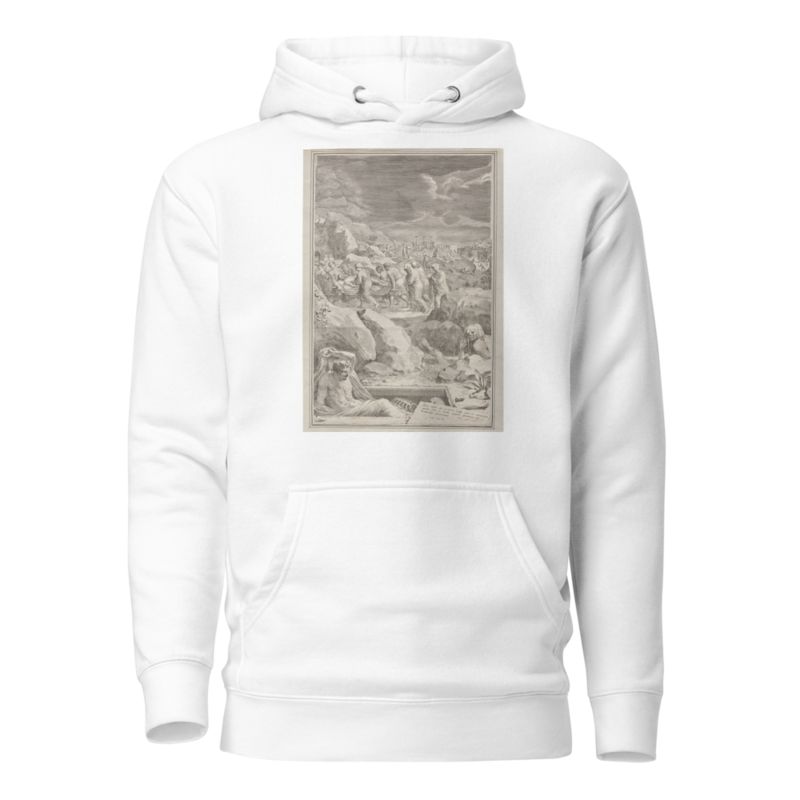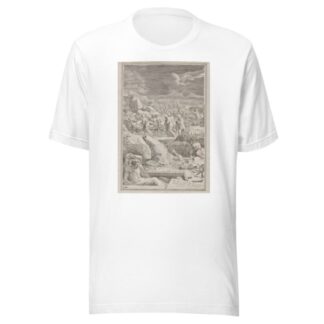Description
Christ Carried to the Tomb by Claude Mellan printed on a Hoodie
About the Hoodie
Modern fit
It provides a more tailored look than a regular fit
Comfortable
The fabric and fit of this item are extra comfy
Tear-away tag
Easily removable tear-away tag that allows you to add a custom inside label
Premium quality
The product is made from premium, high-quality materials
Classic unisex hoodie with a front pouch pocket and matching flat drawstrings. The 100% cotton exterior makes this hoodie soft to the touch.
- 65% ring-spun cotton, 35% polyester
- Charcoal Heather is 60% ring-spun cotton, 40% polyester
- Carbon Grey is 55% ring-spun cotton, 45% polyester
- 100% cotton face
- Fabric weight: 8.5 oz./yd.² (288.2 g/m²)
- Front pouch pocket
- Self-fabric patch on the back
- Matching flat drawstrings
- 3-panel hood
- Tear-away tag
Claude Mellan (1598-1688)
Claude Mellan was a French draughtsman, engraver, and painter.
Mellan was born in Abbeville, the son of a customs official.
His first known print (Préaud no. 288), made for a thesis in theology at the Collège des Mathurins, shows that he was in Paris by 1619. His first teachers have not been identified, but his early engravings are thought to show the influence of Léonard Gaultier.
In 1624 Mellan went to Rome, where he studied engraving for a brief time with Francesco Villamena, who died that year. He then studied under Simon Vouet, who had been in Rome since 1614. Vouet encouraged Mellan to draw, considering it essential for both engraving and painting. Mellan engraved some of Vouet’s works and also began drawing small portraits from life. Many of his portrait drawings were never engraved. He developed a style that was simple and natural, that would be characteristic throughout his later career. Many of his engravings in Rome were reproductive works, including, for example, designs by Pietro da Cortona and Gianlorenzo Bernini. The few after his own designs include Saint Francis de Paul (Préaud no. 77) and the Penitent Magdalene (Préaud no. 113). The plates Mellan engraved in Rome were mostly executed in a conventional manner.
In 1637, after a period of time in Aix-en-Provence with Nicolas-Claude Fabri de Peiresc, he returned to Paris, where he adopted an idiosyncratic technique, in which, instead of creating shade by cross-hatching, he used a system of parallel lines, regulating tone by varying their breadth and closeness.
During this later period in Paris, Mellan mostly engraved his own work. He was much sought after as a portrait artist, drawing from life and engraving the portraits. Among his subjects were members of the royal family of Bourbon. His drawings “reveal more variety of style and execution than he showed in the engravings.” Two examples, for which both a drawing (Nationalmuseum, Stockholm) and an engraving exist, are portraits of Marie-Louise de Gonzague-Nevers (Préaud no. 167) and Henri de Savoie, Duc de Nemours (Préaud no. 182).
He also created large religious works with geometric layouts and poses. According to Barbara Brejon de Lavergnée, writing in The Dictionary of Art, Mellan’s use of the single line gives “an abstract effect” and, “as an engraver he proved sensitive to the classical ideal developed by Nicolas Poussin, Jacques Stella and others in Paris in the middle of the 17th century.” Among Mellan’s reproductive engravings are two frontispieces for religious works after designs by Poussin (1640; Préaud no. 294) and Stella (1641; Préaud no. 296).
Anatole de Montaiglon catalogued 400 engravings by Mellan, and about 100 drawings are known. The latter are mostly in the Stockholm Nationalmuseum (via the collection of Carl Gustav Tessin) and the Hermitage, Saint Petersburg (via the Cobenzl collection). Several of Mellan’s lost paintings are known from his engravings of them, including Samson and Delilah (Préaud no. 5) and Saint John the Baptist in the Desert (Préaud no. 84). A few other paintings were attributed to him, beginning in the 1970s, but these have not been generally accepted.
He died in Paris.






Reviews
There are no reviews yet.